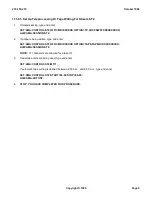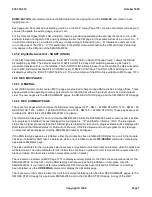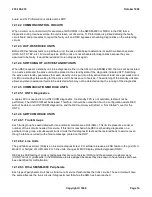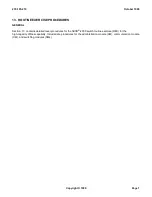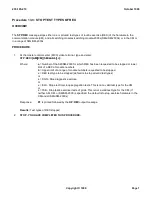
STATUS page can be found in 235-105-110,
System Maintenance Requirements and Tools
.
12.6.3 SM X REX STATUS DISPLAY PAGES
There is a REX STATUS page [1280 (1280 - 1289 for 5E9(2) and later software releases) - SM X REX STATUS] for
each SM/SM-2000. Displayed will be the units equipped for REX in the SM/SM-2000 for which the page is being
displayed, the in-progress or inhibit status of REX on a per-unit basis [with the same characteristics as described for
the 1271 (1271 - 1274 for 5E9(2) and later software releases) - REX STATUS page), and the REX automatic
schedule table for that SM/SM-2000.
NOTE:
The REX schedule is updated daily at midnight. Any changes made after midnight will not take affect until
the following midnight.
The schedule could be updated if the REX administrative module (AM) process is initialized either through a partial
or full initialization or through a single process purge of the REX AM process.
Menu commands are provided for starting a particular exercise type, and an output command will be provided to
obtain a ROP listing of the REX diagnostic summary for the SM/SM-2000. A copy of the REX SM page can be found
in the 235-105-110,
System Maintenance Requirements and Tools
.
12.6.4 CM REX STATUS DISPLAY PAGE
There is a REX STATUS page (1290 - CM REX STATUS) to display the summary status of REX for the CM. The
REX status is displayed for MSGS 0, MSGS 1, ONTC 0, and ONTC 1. The REX status for each of these units is
displayed as described for the 1271 - REX SUMMARY page. This page (1290) also provides a REX automatic
schedule table for the CM REX like that for the SM Page 1280. It also provides commands to start REX and to print
on the ROP the REX diagnostic summary for the CM. A copy of the REX CM page can be found in 235-105-110,
System Maintenance Requirements and Tools
.
12.7 REX SCHEDULING ALGORITHMS
12.7.1 COMMUNICATION MODULE UNITS
In the CM, two types of tests can be performed: a SWITCH or a DGN. When the SWITCH test typs is requested,
the result is a soft switch of the CMP, followed by the FPC, then the PPC, and then the ONTC. When the DGN test
type is requested, the standby CMP, FPC and PPC are scheduled for test. These two or three units are always
scheduled for test in the CM whenever diagnostics are requested to run.
Next, REX schedules the rest of the units in a round-robin algorithm. This means that REX will start scheduling test
on the last unit that it had stopped during the last invocation and continue either until it has reached the same unit
that it originally started with in the CM or until it is stopped. The stop could come from the manual
STP:REX
command or from the automatic scheduler if the allotted time given to CM REX runs out. The round-robin algorithm
assures that each unit is exercised. This scheme allows large offices to complete CM REX in one or more
invocations.
12.7.2 SWITCHING MODULE UNITS
As mentioned previously, there are three test types that can be scheduled in an SM/SM-2000: ELS, FAB, and DGN.
ELS and FAB tests are scheduled in the same manner. Both start scheduling the grid in the line unit that it had
stopped on previously and proceeds to test all the grids in the module until all grids in each line unit have been
tested. If the test is not stopped via a manual command or because the time allowed has run out, they will stop on
the same grid that they had originally started on. It should be noted that, even though the tests that ELS and FAB
perform are different, the algorithm that is used to schedule the grids is similar.
The algorithm used to schedule diagnostics is similar to that of the CM. There are global units, such as the MCTSI,
235-105-210
October 1999
Copyright © 1999
Page 8
Summary of Contents for 5ESS-2000
Page 96: ...235 105 210 October 1999 Copyright 1999 Page 2 ...
Page 184: ...235 105 210 October 1999 Copyright 1999 Page 3 ...
Page 300: ...13 STOP YOU HAVE COMPLETED THIS PROCEDURE 235 105 210 October 1999 Copyright 1999 Page 55 ...
Page 339: ...7 STOP YOU HAVE COMPLETED THIS PROCEDURE 235 105 210 October 1999 Copyright 1999 Page 13 ...
Page 342: ...235 105 210 October 1999 Copyright 1999 Page 2 ...
Page 359: ...235 105 210 October 1999 Copyright 1999 Page 5 ...
Page 609: ...2 STOP YOU HAVE COMPLETED THIS PROCEDURE 235 105 210 October 1999 Copyright 1999 Page 12 ...
Page 676: ...235 105 210 October 1999 Copyright 1999 Page 9 ...
Page 792: ...3 STOP YOU HAVE COMPLETED THIS PROCEDURE 235 105 210 October 1999 Copyright 1999 Page 9 ...
Page 799: ...Figure 11 36 3 1 Cleaning Points 235 105 210 October 1999 Copyright 1999 Page 7 ...
Page 801: ...235 105 210 October 1999 Copyright 1999 Page 9 ...
Page 839: ...2 STOP YOU HAVE COMPLETED THIS PROCEDURE 235 105 210 October 1999 Copyright 1999 Page 16 ...
Page 999: ...2 STOP YOU HAVE COMPLETED THIS PROCEDURE 235 105 210 October 1999 Copyright 1999 Page 13 ...
Page 1008: ...Figure 11 55 1 CTSNS DIP Switch Settings 235 105 210 October 1999 Copyright 1999 Page 2 ...
Page 1011: ...235 105 210 October 1999 Copyright 1999 Page 5 ...
Page 1053: ...235 105 210 October 1999 Copyright 1999 Page 15 ...
Page 1289: ...Figure 15 17 2 AMATPS Data Link 235 105 210 October 1999 Copyright 1999 Page 2 ...
Page 1292: ...235 105 210 October 1999 Copyright 1999 Page 5 ...
Page 1303: ...9 STOP YOU HAVE COMPLETED THIS PROCEDURE 235 105 210 October 1999 Copyright 1999 Page 2 ...
Page 1360: ...Figure 15 47 2 Typical SCANS III Link Diagram 235 105 210 October 1999 Copyright 1999 Page 2 ...
Page 1372: ...235 105 210 October 1999 Copyright 1999 Page 2 ...
Page 1374: ...235 105 210 October 1999 Copyright 1999 Page 4 ...
Page 1421: ...Table 1 1 O M Checklist 235 105 210 October 1999 Copyright 1999 Page 3 ...







